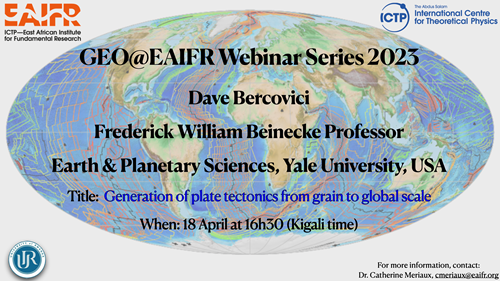ICTP-East African Institute for Fundamental Research
KIST2 Building CST
Nyarugenge Campus
University of Rwanda
Kigali, Rwanda
GEO@EAIFR Webinar Series 2023
David Bercovici, Frederick William Beinecke Professor of Earth & Planetary Sciences, from Yale University, will discuss the generation of plate tectonics from grain to global scale.

The East African Institute for Fundamental Research (EAIFR) and the International Centre for Theoretical Physics (ICTP) wish to inform those who may be interested of a GEO@EAIFR webinar. This seminar will take place on April 18, 2023 and will be broadcast live on ZOOM. It will also be recorded and later posted on the ICTP-EAIFR YouTube channel, where one can find the previous recorded GEO@EAIFR webinars. Below all the details:
Speaker: David Bercovici, Frederick William Beinecke Professor of Earth and Planetary Sciences, Yale University, USA.
Title: Generation of plate tectonics from grain to global scale.
When: April 18, 2023 at 16:30 (Kigali time).
Register in advance for this meeting by clicking here.
All are very welcome.
Biography:
David Bercovici received his BS in Physics from Harvey Mudd College (1982) and his PhD in Geophysics and Space Physics from UCLA (1989). After a postdoctoral fellowship at the Woods Hole Oceanographic Institution (1989-1990), he joined the faculty at the University of Hawaii (1990-2000). He moved to Yale in 2001 and has been there ever since as Professor and Chair (twice: 2006-2012, 2018-2021). He is currently now the co-director of the Yale Center for Natural Carbon Capture (since 2021). Bercovici received the Macelwane Medal from the American Geophysical Union (AGU), along with AGU Fellowship in 1996, and the EGU Love Medal in 2022. He is a member of the U.S. National Academy of Sciences (2018) and the American Academy of Arts and Sciences (2015). He is the author of the (semi-)popular science book "The Origins of Everything in 100 Page (More or Less)" (Yale Press, 2016). His research is broadly in planetary physics and geophysical fluid dynamics.
Abstract:
The physics of rock deformation in the lithosphere governs the formation of tectonic plates, which are characterized by strong, broad plate interiors, separated by weak, localized plate boundaries. The size of mineral grains in particular controls rock strength, and grain-reduction can lead to shear localization and weakening in the strong ductile portion of the lithosphere. Grain damage theory describes the competition between grain growth and grain size reduction as a result of deformation, and the effect of grain size evolution on the rheological properties of lithospheric rocks. The self-weakening feedback predicted by grain damage theory can explain the formation of mylonites, typically found in deep ductile lithospheric shear zones, which are characteristic of localized tectonic plate boundaries. The amplification of damage is most effective when mineralogical phases, like olivine and pyroxene, are well mixed on the grain scale. Grain mixing theory predicts two co-existing deformation states of unmixed materials undergoing slow strain-rate, and well-mixed materials with large strain-rate; this is in agreement with recent laboratory experiments, and is analogous to Earth’s plate-like state.



